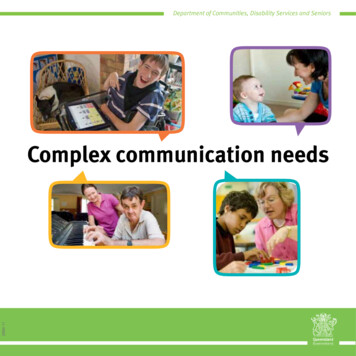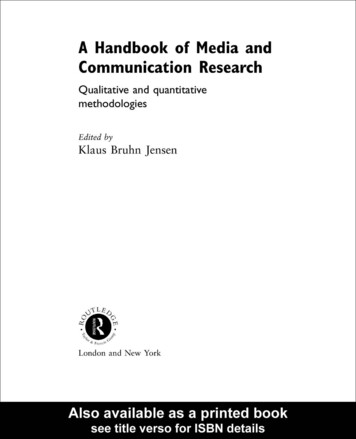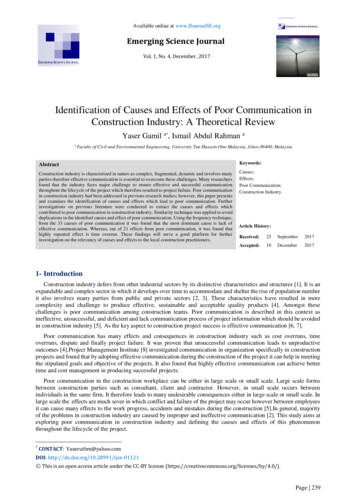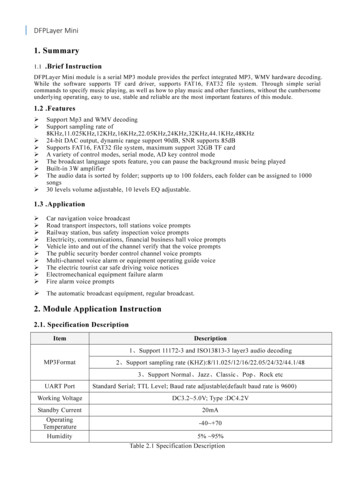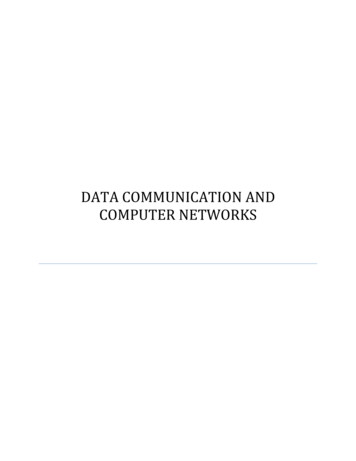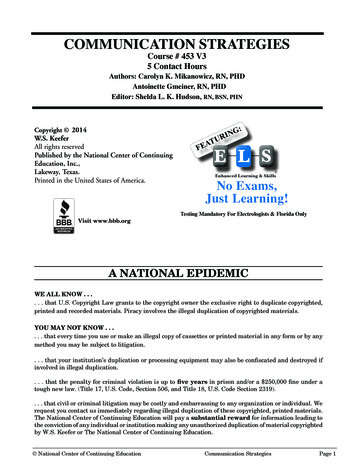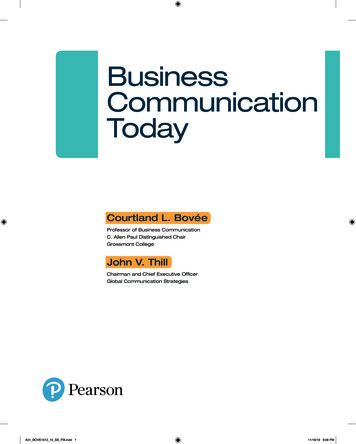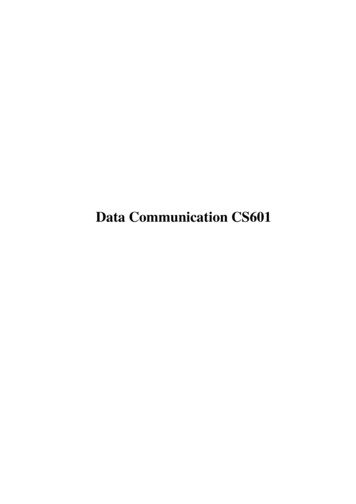
Transcription
Data Communication CS601
CS601-Data CommunicationVUTable of ContentsLecture No. 1 .3Lecture No. 2 .12Lecture No. 3 .17Lecture No. 4 .22Lecture No. 5 .28Lecture No. 6 .33Lecture No. 7 .39Lecture No. 8 .44Lecture No. 9 .49Lecture No. 10 .52Lecture No. 11 .56Lecture No. 12 .61Lecture No. 13 .66Lecture No. 14 .70Lecture No. 15 .75Lecture No. 16 .79Lecture No. 17 .84Lecture No. 18 .89Lecture No. 19 .95Lecture No. 20 .98Lecture No. 21 .101Lecture No. 22 .108Lecture No. 23 .114Lecture No. 24 .118Lecture No. 25 .124Lecture No. 26 .130Lecture No. 27 .135Lecture No. 28 .142Lecture No. 29 .146Lecture No. 30 .156Lecture No. 31 .160Lecture No. 32 .165Lecture No. 33 .169Lecture No. 34 .174Lecture No. 35 .179Lecture No. 36 .183Lecture No. 37 .188Lecture No. 38 .193Lecture No. 39 .199Lecture No. 40 .205Lecture No. 41 .210Lecture No. 42 .218Lecture No. 43 .227Lecture No. 44 .233Lecture No. 45 .239 Copyright Virtual University of Pakistan2
CS601-Data CommunicationVULECTURE #1Course Outline The course will consist of :–45 lectures–10-14 assignments–2exams (1 midterm and 1 final)–GMDB Grading Criteria:–One Midterm: 35 %–Final Exam: 45%–Assignments: 15%–GMDB: 5%Textbook “Data Communications and Networking” 4th Edition by Behrouz A. Forouzan “Data and Computer Communication” 6th Edition by William Stallings Copyright Virtual University of Pakistan3
CS601-Data CommunicationVUINTRODUCTION TO DATA COMMUNICATIONDEFINITION OF DATA COMMUNICATION“Data Communication is the exchange of Information from one entity to the otherusing a Transmission Medium”.DEFINITION OF DATA COMMUNICATION (Cont’d)As you can clearly notice, the definition of Data Communication although Simpleleaves many questions ?Transmission?Medium?We will try to answer all these Questions in this CourseHistory of Data CommunicationData communications history represents a blend of histories, including:¾ The history of the telecommunications industry¾ The history of data communications, and¾ The history of the Internet Telegraph 1837 Samuel MorseModern telecommunication industry began in 1837 with the invention ofthe telegraph by Samuel MorseThis led to building a telecommunications infrastructure of poles and wiresas well as to the development of communication hardware and protocols Telephone 1876 Alexander Graham BellInvention of telephone by Alexander Graham Bell in 1876 and thedevelopment of wireless communication technology by GuglielmoMarconi in the 1890s set the stage for today’s communication industry By 1950’sBy 1950s, telephone and telegraph companies had developed a network ofcommunication facilities throughout the industrialized world 1970’SAlthough development of databases, languages, operating systems, andhardware was strong from 1950s to 1970s, large-scale data communicationsystems did not emerge until the 1970s.This was stimulated by 3 major developments:¾ Large-scale integration of circuits reduced cost and size ofterminals and communication equipment Copyright Virtual University of Pakistan4
CS601-Data CommunicationVU¾ New software systems that facilitated the development ofdata communication networks¾ Competition among providers of transmission facilitiesreduced the cost of data circuitsTODAY’S EVERGHANGING & BUSY WORLDo Today’s fast world demands better, secure and most of all FAST ways ofcommunicationo Gone are the days when you had to wait a couple of weeks to get a letter fromUSAo Why wait ONE week when you can get the information you require in just a splitof a second, using what we know by the name of “DATACOMMUNICATION”.HOW TO ACHIEVE THIS?o How to achieve this ACCURACY, SECURITY and SPEED for the transfer ofthis information?o What HARDWARE and the SOFTWARE is needed?o And, what should be the MEANS of sending this info?ARE SOME OF TOPIC WE WILL BE EXPLORING DURING THE COURSE OFOUR STUDYDATA COMMUNICATIONWhen we communicate , we share informationInformation can be LOCAL or REMOTEBetween Individuals LOCAL communication occurs face to faceREMOTE communication occurs over a long distanceWhen we refer to COMPUTER SYSTEMS, Data is represented in the form ofBinary Units (Bits) in the form of Zeros (0’s) and One’s (1’s)o Also the entities can most of the times be considered to be COMPUTERSoooooData Communication Definition (Modified)Therefore, our earlier definition can easily be modified to:“Data Communication is the exchange of data (in the form of 0’s and 1’s)between two devices (computers) via some form of the transmission medium.”LOCAL and REMOTE Data Communication LOCALData communication is considered to be local if the communicating devicesare present in the same building or a similarly restricted geographical area Copyright Virtual University of Pakistan5
CS601-Data CommunicationVU REMOTEData Communication is considered remote, if the devices are farther apart.VAGUE DEFINITIONSWe will clarifyData Communication SystemFor Data Communication to occur, the communicating devices must be a part of acommunication system made up of some specific kind of hardware and softwareThis type of a system is known as a“DATA COMMUNICATION SYSTEM”Effectiveness of Data Comm. SystemEffectiveness depends upon three fundamental characteristics:¾ Delivery¾ Accuracy¾ Timeliness (Better NEVER than LATE)9 Example of the POSTAL MAILComponents of Data Comm. SystemsComponents of Data Com SystemsAny system is made up of more than one component. Similarly, a data communicationsystem is made up of 5 components as shown in the fig:¾¾¾¾¾MessageSenderReceiverMediumProtocol Copyright Virtual University of Pakistan6
CS601-Data CommunicationVU MESSAGE¾ Information or Data to be communicated¾ Can be text, numbers, video or any combination of these¾ In short anything that can be represented using binary bitsData Communication Messages9 Files (meaningful collections of records)9 Data/information requests (database queries, Web page requests,etc.)9 Responses to requests and commands or error messages9 Status messages (about the network’s functional status)9 Control messages transmitted between network devices to controlnetwork traffic9 Correspondence among network usersMESSAGE TYPES SENDER SENDER¾ Device that sends the data message¾ Can be a Computer , Workstation, Video camera etc¾ As already discussed, the data from the sender might not be in theappropriate format for the transmission medium and will need to beprocessed RECEIVER¾ Device that receives the message¾ Can be a computer, workstation, Television etc¾ At times, the data received from the transmission medium may notbe in a proper form to be supplied to the receiver and it must beprocessed Copyright Virtual University of Pakistan7
CS601-Data CommunicationVU MEDIUM¾ Physical path that a message uses to travel from the Sender to theReceiver¾ Can be a Copper Cable (Telephone), Coaxial Cable (Cable TV),Fiber Optic Cable, LASERS or Radio Waves (Wireless Medium)¾ We will see that Data needs to be transferred in the form ofELECTROMAGNETIC signals and The Transmission Mediumshould be capable of carrying these EM Signals¾ Transmission MediaTransmission MediaSpeedMediumCostTwisted xial Cable56Kbps-200MbpsLowFiber Optic Cable500Kbps-10GbpsHigh PROTOCOL¾ Set of Rules Governing Communication¾ Represents an Agreement between communication devices¾ Without Protocol, two devices may be connected but they will notbe able to communicate9 EXAMPLE: Consider the communication between twoindividuals. They can only communicate provided they bothspeak the same language.A little more complex Comm. System Copyright Virtual University of Pakistan8
CS601-Data CommunicationVUEXAMPLE – ELECTRONIC MAILExplanation In Terms of a little more complex Comm. System SENDER SIDE¾¾¾¾¾¾Input device and transmitter are components of a Personal ComputerUser of a PC wishes to send a message ‘m’User activates electronic mail package e.g. hotmailEnters the message via input device (keyboard)Character string is buffered in main memory as a sequence of bits ‘g’PC is connected to some trans system such as a Telephone Network viaan I/O Transmitter like Modem¾ Transmitter converts incoming stream ‘g’ into a signal ‘s’ RECEIVER SIDE¾ The transmitted signal ‘s’ is subject to a number of impairmentsdepending upon the medium¾ Therefore, received signal ‘r’ may differ from ‘s’.¾ Receiver attempts to estimate original ‘s’ based on its knowledge ofthe medium and received signal ‘r’¾ Receiver produces a bit stream g’(t)¾ Briefly buffered in the memory¾ Data is presented to the user via an output device like printer, screenetc. Copyright Virtual University of Pakistan9
CS601-Data CommunicationVU¾ The data viewed by user m’ will usually be an exact copy of the datasent ‘m’EXAMPLE-Telephone Systemo Input to the Telephone is a message ‘m’ in the form of sound waveso The sound waves are converted by telephone into electric signals of the samefrequencyo These signals are transmitted w/o any modification over the telephone lineo Hence g(t) and s(t) are identicalo S(t) will suffer some distortion so that r(t) will not be the same as s(t)o R(t) is converted back to sound waves with no attempt of correction orimprovement of signal qualityo Thus m’ is not an exact replica of mAn Actual Digital Data Communication System Key DataCommunication Terminology Session: communication dialog between network users or applicationsDifferent Types of this session for Info Exchange Network: interconnected group of computers and communication devicesWe will look into it in a little bit Node: a network-attached deviceNode can be any device in the network Copyright Virtual University of Pakistan10
CS601-Data CommunicationVUSummary Data Communication Brief History of Communication Data Communication System Key Data Communication TerminologyReading Sections Section 1.2, “Data Communications and Networking” 4th Edition by Behrouz A.Forouzan Sections 1.1, 1.2, “Data and Computer Communication” 6th Edition by WilliamStallings Copyright Virtual University of Pakistan11
CS601-Data CommunicationVULECTURE #2KEY DATA COMMUNICATION TERMINOLOGY Link: connects adjacent nodesWires, Cables, Any thing that physically connects two nodes Path: end-to-end route within a network Circuit: the conduit over which data travels Packetizing: dividing messages into fixed-length packets prior to transmissionover a network’s communication media Routing: determining a message’s path from sending to receiving nodes9 The transmission medium may itself be a network, so route needs tobe specifiedNetwork“A NETWORK is a set of devices (Nodes) connected by Communication Links” Node: Can be a Computer, Printer or any other device capable of sending orreceiving¾ The links connecting Nodes are called COMMUNICATION CHANNELSNetworks- Why we need them?Networks- Why we need them?It is often impractical for devices to be directly connected for two major reasons:o The devices are very far apart. They are expensive to connect just two deviceswith one in Lahore and other in Islamabado Large set of devices would need impractical number of connections e .g.Telephone Lines in the world and all the computers owned by a singleorganizationSolution to the Problem Networkso Solution is to connect all devices to a central system known as a NETWORK inwhich all terminals or computers share the links.o Two Main Classifications of the Networks Copyright Virtual University of Pakistan12
CS601-Data CommunicationVU¾ LANS¾ WANSDISTRIBUTED PROCESSINGo Instead of a single large machine being responsible for all aspects of a process ,each separate computer handles a subset of the task9 Example – Project Given as a part of the Course9 Example – Office WorkAdvantages of Distributed Processing SecurityA system designer can limit the kind of interaction that a given user can have withthe entire system.9 For example : Bank’s ATM Distributed Data basesNo one system need to provide storage capacity for the entire database9 For example WWW gives user access to pages stored anywhere onInternet Faster Problem SolvingMultiple computers working on a problem can solve a problem faster than acomputer working alone Security through RedundancyMultiple computers running the same program provide security throughredundancyIf one computer hardware breaks down then others cover up. Collaborative ProcessingBoth multiple computers and multiple users can interact for a taskNetwork Criteria Copyright Virtual University of Pakistan13
CS601-Data CommunicationVU PerformanceCan be measured in many ways including Transit and Response Timeo Depends on a no. of Factors:¾¾¾¾¾Number of USERSType of Transmission MediumHardwareSoftwareNetwork Criteria¾ Number of USERS9 Large Number of concurrent users slow network9 Design of a network9 Peak Load Periods9 Network Criteria¾ Type of Transmission Medium9 Medium defines speed at which data can travel9 Fiber Optic Cable9 100Mbps and 10 Mbps9 Hardware9 Software¾ Hardware9999Effect speed and the capacity of transmissionFast computer with large storage capacitySoftwareNetwork Criteria¾ Software Copyright Virtual University of Pakistan14
CS601-Data CommunicationVU9 Software processes data at sender , receiver andintermediate nodes9 All communication steps need software:9 Moving message from node to node9 Transforming,9 Processing at the sender and receiver9 Error Free DeliveryWell designed software can speed up the process Reliabilityo Depends on a no. of Factors:¾¾¾¾Frequency of FailureRecovery Time of a Network after FailureCatastropheFire , Earthquake or Theft Securityo Unauthorized Access¾¾¾¾Sensitive dataProtection at multiple levels:Lower level: Passwords and user ID codesUpper Level: Encryptiono VirusesNetwork Applications Marketing and Saleso Marketing¾ Collect, exchange and analyze data relating to the customers needs¾ Product development cycleso Sales¾ Tele shopping,¾ On line reservation systems Financial Serviceso Online Bankingo Foreign Exchange Transferso Rates Manufacturing Copyright Virtual University of Pakistan15
CS601-Data CommunicationVUo Computer Aided Designo Computer Assisted Manufacturingo Network Applications Electronic Messaging TeleconferencingooooConferences to occur w/o participants at the same placeChatVoice ConferencingVideo Conferencing Cable TelevisionSummary Key Data Communication TerminologyNetworks and why we need them?Distributed ProcessingNetwork CriteriaNetwork ApplicationsReading Sections Section 1.3, “Data Communications and Networking” 4th Edition by Behrouz A.Forouzan Sections 1.3, “Data and Computer Communication” 6th Edition by WilliamStallings Copyright Virtual University of Pakistan16
CS601-Data CommunicationVULECTURE #3Communication TasksThere are some key tasks that must be performed in a data communication systemElements can be added, deleted, or merged togetherTransmission System utilizationInterfacingSignal GenerationSynchronizationExchange ManagementError Detection and CorrectionFlow ControlAddressingRoutingRecoverySecurityNetwork Management Transmission System UtilizationNeed to make efficient use of Transmission facilities that are shared among a no.of communicating devicesFor Example:9 Techniques like Multiplexing to allow multiple users to share totalcapacity of a Transmission Medium9 Congestion Control: TX. System should not be overwhelmed by traffic InterfacingA device must have an Interface with the Transmission System/TransmissionMedium Signal GenerationElectromagnetic Signals travel over Transmission Medium. Once an interface isestablished, Signal generation is required¾ Properties of Signals9 Capable of being propagated over TX. Medium9 Interpretable as data at the Receiver SynchronizationThe transmission and the reception should be properly synchronized.Synchronization means that the receiver must be able to determine, when to Copyright Virtual University of Pakistan17
CS601-Data CommunicationVUexpect a new transmission and when to send acknowledgements. In other wordstransmitter and receiver should have an agreement on the nature as well as timingof the signals Exchange ManagementIf the data needs to be exchanged in both directions over a period of time, bothparties must cooperate as follows¾¾¾¾Whether both devices must transmit simultaneously or take turnsAmount of Data to be sent at one timeFormat f the DataWhat to do when an Error Arises Error Detection and CorrectionIn all comm. Systems, there is a potential risk for errors and impairments.Tx. Signals are distorted to some extent before reaching their destination. ErrorDetection & Correction needs to be employed in Data Processing Systems where achange in say the contents of a file cannot be tolerated Flow ControlTo make sure that source does not overwhelm destination by sending data fasterthan it can be handled and processed Addressing & RoutingIf TX facility is shared by two or more devices, source must specify the identity orthe address of the destination system and if Tx. System is itself a system, a properroute must be allocated that the data will take in order to reach the desireddestination RecoveryIf a data transmission is interrupted due to a fault somewhere in the system,recovery techniques are needed. The objective is either to resume activity at thepoint of interruption and to restore the state of the system to what it was prior tothe interruption SecuritySecurity is very important issue in a Data Communication System. The senderneeds to be assured that¾ Only the Intended receiver receives the data¾ Data is delivered unalteredIntroduction to ProtocolIn computer Networks, communication occurs between two entities in different systems.o Entity is anything sending and receiving informationo SYSTEM is a physical object containing more than one entities Copyright Virtual University of Pakistan18
CS601-Data CommunicationVUNow, two entities in different systems cannot just send data and expect to be understood.For communication to occur, these entities must agree on a PROTOCOLPROTOCOLSAs discussed earlier, “Protocol is a set of rules governing communication”o Two computers cannot just send bit streams to each other and expect to beunderstoodo Entities must agree on a PROTOCOL9 Same Example French and GermanProtocol defines:¾ What is Communicated?¾ How it is Communicated?¾ When it is Communicated?KEY elements of a PROTOCOL Syntax:¾ Represents the Structure or the format of the Data¾ Meaning the order in which data is presentedFor Example9 First eight bits to be Sender address9 Next eight to be Receiver’s Address9 The Rest to be Data Semantics:¾ Refer to the Meaning of each section of bits¾ How is a particular pattern to be interpreted?¾ What action should be taken based on interpretation?For Example9 Does an address identify the route to be taken or the final destination of themessage? TimingRefers to 2 characteristics:¾ When data should be sent?¾ How fast it should be sent?For Example9 If sender produces data at 100 Mbps9 But Receiver can only process data at 1 Mbps9 The TX. will overload receiver and data will be lost Copyright Virtual University of Pakistan19
CS601-Data CommunicationVUProtocol ArchitectureInstead of having a single Module for performing communication, there is a structured setof modules that implement communications function”This structure is called Protocol ArchitectureLet’s explain it by an example of File transfer system.Simplified File Transfer Architecture In the above example File transfer could use three modules¾ File transfer application¾ Communication service module¾ Network access module File transfer applicationFile Transfer contains all of the logic is unique to the file transfer application such as:¾ Transmitting passwords¾ File Commands9 Checking File System on other machine if it is ready9 Check File System Compatibility¾ File records Communication service moduleInstead of allowing File Transfer Module to deal with actual transfer of data andcommands, we can have a separate module for this transfer. This module must makesure that the receiver system is ready to receive and look into the reliable exchange ofdata Network access moduleNature of the exchange between systems is independent of the network that connectsthem. That allows us to have a 3rd module that handles the details of the Networkinterface and interacts with the network. If Network to be used changes, only Networkaccess Module has to change Copyright Virtual University of Pakistan20
CS601-Data CommunicationVUCharacteristics of a Protocol¾¾¾¾Direct or indirectMonolithic or structuredSymmetric or asymmetricStandard or nonstandard Direct¾ Systems share a point to point link or¾ Data can pass without intervening active agent¾ Simple Protocol Indirect¾¾¾¾Switched networks orInterne works or internetsData transfer depend on other entitiesComplex Protocol Monolithic or Structured¾¾¾¾Communications is a complex taskTo complex for single unitStructured design breaks down problem into smaller unitsLayered structure Symmetric or AsymmetricSymmetric¾ Communication between peer entitiesAsymmetric¾ Client/serverStandard or Nonstandard¾ Nonstandard protocols built for specific computers and tasksSummary Communication TasksProtocolsProtocol ArchitectureCharacteristics of a ProtocolReading Sections Section 1.4 “Data Communications and Networking” 4th Edition by Behrouz A.Forouzan Sections 1.1,2.1 “Data and Computer Communication” 6th Edition by WilliamStallings Copyright Virtual University of Pakistan21
CS601-Data CommunicationVULECTURE #4Standards“A standard provides a model for development that makes it possible for a productto work regardless of the individual manufacturer ”¾ A great deal of coordination and cooperation is required by the devices tocommunicate¾ A device prepared by a specific manufacturer may not be compatible with thedevices prepared by other manufacturers¾ Unavailability of standards creates problems and puts a halt to product growth9 An example of non-standardized products is AUTOMOBILESWhy Standards are Essential?Standards are therefore essential in:o Creating and Maintaining an Open and competitive Market for EquipmentManufacturerso Guaranteeing National and International Interoperability of Data andTelecommunications Technology and EquipmentLet us understand this using an EXAMPLENOTE K sources and L receivers leads to K*L protocols and 2*K*L implementations If common protocol used, K L implementations needed Copyright Virtual University of Pakistan22
CS601-Data CommunicationVUCategories of Data Communication StandardsStandardsDe jure(By Law)De facto(By Fact)ProprietaryNon Proprietary De facto (By fact or By Convention)Standards not approved by an organized body but have been adopted as standardsthrough their widespread use De jure (By Law or By Regulation)Standards that have been legislated by an officially recognized regulation bodySubdivision of De Facto Standards¾ PROPRIETARY (Closed Standards)Standards that are originally invented by a Commercial Organizationas a basis for the operation of its products they are wholly owned bythat company. They are also called Closed Standards because theyclose off Communication between systems¾ NON- PROPRIETARY (Open Standards)They are originally developed by groups or committees that havepassed them into public domains. They are also called Open Standardsbecause they open Communication between different systemsStandard OrganizationsStandards are developed mainly by 3 entities:¾ Standard Creation Committees¾ Forums¾ Regulatory Agencies Copyright Virtual University of Pakistan23
CS601-Data CommunicationVU Standard Creation CommitteesThey are Procedural Bodies and they are so slow moving and cannot co-op with the fastgrowing communication industry.¾ ISO999999International Standard’s OrganizationVoluntary OrganizationCreated in 1947Members are from Standard Creation Committees of different countriesIncludes representatives from 82 countriesOpen System Interconnection (OSI) Model¾ ITU-T9 By 1970s a lot of countries were defining standards but there was noInternational compatibility9 United Nations made as a part of their ITU9 Consultative Committee for International Telegraphy and Telephony(CCITT)9 IN 1993 , ITU-Telecomm Standards Sector9 Important ITU-T Standards9 V Series (V32, V33, V42, Define Data Transmission over phone lines9 X Series(X.25, 400, 500): Define Transmission over Public DigitalNetwork9 ISDN: Integrated Services Digital Network¾ The American National Standard Institute (ANSI)9 Private-Non Profit Cooperation not affiliated with US Government9 Members include professional societies, industrial associations, govt. andregulatory bodies9 Submits proposal to ITU-T and is a voting member for USA in ISO¾ The Institute of Electrical and Electronics Engineers (IEEE)9 Largest professional engineering society in the world9 Also oversees the development of Telecommunication and WirelessInternational Standards9 Special committee for LANS out of which emerged Project 802 (802.
Data Communication System For Data Communication to occur, the communicating devices must be a part of a communication system made up of some specific kind of hardware and software This type of a system is known as a “DATA COMMUNICATION SYSTEM” Effectiveness of Data Comm. System Effe

